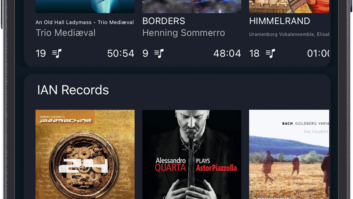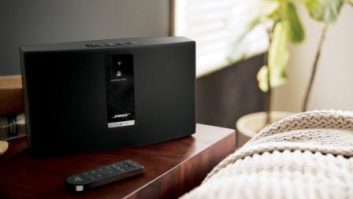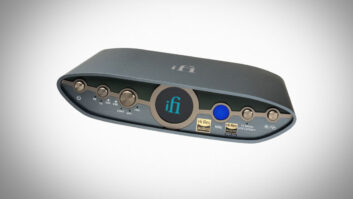San Diego — Sony is stepping up its efforts to promote high-resolution audio (HRA) downloads while the CE and music industries continue working together to develop a common HRA definition, unified messages to consumers, and strategies to promote better audio to music enthusiasts, Sony marketers said during a press briefing.
Representatives of DEG: The Digital Entertainment Group and Universal Music Group participated in the briefing, which emphasized that many younger music enthusiasts don’t realize their downloads don’t sound anything like what the artists intended.
With the advent of compressed music, consumers “sacrificed quality in order to get convenience,” but in the age of high-resolution downloads and ample low-cost data storage, consumers “can get better sound without sacrificing convenience,” said Sony home audio division director Jeff Hiatt.
Now is the time to promote HRA because the digital download market has matured in the U.S., where the dollar volume of downloads fell 2 percent in 2013, said Jim Belcher, Universal’s digital technology and production VP. Digital downloads accounted for 60 percent of the American music industry’s dollar volume in 2013, Belcher added in citing statistics from the International Federation of the Phonographic Industry (IFPI).
The music industry continues to make progress in getting more high-resolution music out faster to download stores, but challenges remain to widespread adoption, including a need for more high-resolution portable media players and smartphones, the participants said.
They also pointed out that the movement to promote HRA started to crystalize only six months ago, and DEG senior director Marc Finer said he is hopeful that during June’s CE Week in New York, “a number of concrete steps” will be announced by the CE and music industries to promote HRA.
In the meantime, Sony plans in May to launch a new HRA promotion in which purchasers of any Sony high-resolution product get a free high-resolution download of Xscape, the second posthumous album of previously unreleased Michael Jackson tracks. The album will be released by Sony Music Entertainment.
Purchasers of select audio products not part of Sony’s HRA lineup will get a free MP3 version of the album.
The promotion will be a “big focus” over the next several months, Hiatt said.
On top of that, Sony is expanding the number of HRA events that it will hold at stores. “We’re getting more requests from dealers,” said product marketing manager Aaron Levine. Sony held 10 events last month, and 10 more will be held in April.
Sony also promotes HRA through print and digital ads, dealer materials, and dealer advertising, Levine added. HRA ads have featured musicians Sting and John Mayer, but other artists will appear in a new round of ads, said Hiatt.
Sony has also taken its high-resolution message to consumers at consumer audio shows and at SXSW.
Although Sony has been the most aggressive HRA promoter to date among CE suppliers, Levine said he expects other CE suppliers to step up their promotion efforts. Manufacturer participation began when CEA “reached out to manufacturers who played in the [high-resolution] space but didn’t focus on it,” Finer noted.
To promote HRA within the music industry, Sony is working with DEG, the Audio Engineering Society, and other industry groups to ensure artists and engineers understand the concept, said Hiatt. Sony is also working with CEA board members to drive HRA growth.
For its part, Best Buy is working with CEA’s audio division, which is “working on messaging and exploring how to take that messaging to expand it to retail,” added DEG’s Finer.
Sources of high-res downloads consist of a half dozen on-line stores that support high-resolution downloads in such formats as 96kHz/24-bit and 192/24-bit FLAC and PCM as well as in DSD from the big three music companies and others in classical, jazz and pop genres.
High-res download sites don’t include the largest and best-known download stores operated by Apple, Amazon and Google, but DEG’s Finer contended that “if there is enough consumer response, it’s bound to start to spread to other providers and platforms (such as streaming sites).”
Universal’s Belcher noted that Apple “is aware of the desire for higher quality audio,” pointing to songs designated as “Mastered for iTunes” in the iTunes store. Marketers note, however, that the tunes are still encoded in lossy 256kbps AAC, though they’re made using tools to avoid distortion when making compressed files from 24-bit uncompressed files.
For its part, Universal is kickstarting the market in several ways, in part by making its catalog available for HRA remastering from the original sources, said Belcher. The company is also digitally archiving music in high-resolution PCM instead of CD-quality PCM like before, and the company is now feeding HRA files to download stores without distributing them on hard drives.
As the high-res market grows, artists, producers and engineers will be incentivized to create more HRA music, Belcher said.
For now, high-res downloads are pricier than lower resolution downloads because they are premium products, they require more bandwidth to distribute, and the market is young, Belcher said. But with more download stored getting into the high-res market, “I’m sure we’ll see some price flexibility.”
One issue to be resolved is the definition of high resolution. Sony defines it as anything better than CD-quality 16-bit/44.1kHz digital audio, though Belcher noted that many in the music industry say 24-bit/96kHz files represent the baseline.
Multiple high-resolution formats represent another industry challenge, but Sony is solving that issue by supporting all common high-res formats, including DSD, in almost all of its HRA products. Some don’t support double DSD, and one high-res AVR doesn’t support DSD or double DSD but supports all other high-res formats up to 192/24.
Another challenge is the need for more high-res portable-audio products because they represent “an opportunity to make accessibility greater,” said Hiatt. Sony is investigating the launch of a Walkman-type product, he said, and wants to see high-res playback available in more smartphones.













